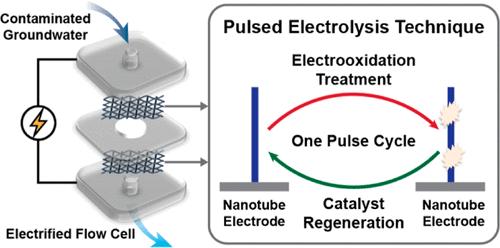当前位置:
X-MOL 学术
›
Environ. Sci. Technol.
›
论文详情
Our official English website, www.x-mol.net, welcomes your
feedback! (Note: you will need to create a separate account there.)
Tackling Challenges of Long-Term Electrode Stability in Electrochemical Treatment of 1,4-Dioxane in Groundwater
Environmental Science & Technology ( IF 10.8 ) Pub Date : 2024-07-16 , DOI: 10.1021/acs.est.4c03189
Wensi Chen 1, 2 , Kali Rigby 1 , Hyun Jeong Lim 1, 3 , David J Kim 1 , Jae-Hong Kim 1
Environmental Science & Technology ( IF 10.8 ) Pub Date : 2024-07-16 , DOI: 10.1021/acs.est.4c03189
Wensi Chen 1, 2 , Kali Rigby 1 , Hyun Jeong Lim 1, 3 , David J Kim 1 , Jae-Hong Kim 1
Affiliation

|
Electrochemical advanced oxidation is an appealing point-of-use groundwater treatment option for removing pollutants such as 1,4-dioxane, which is difficult to remove by using conventional separation-based techniques. This study addresses a critical challenge in employing electrochemical cells in practical groundwater treatment─electrode stability over long-term operation. This study aims to simulate realistic environmental scenarios by significantly extending the experimental time scale, testing a flow-through cell in addition to a batch reactor, and employing an electrolyte with a conductivity equivalent to that of groundwater. We first constructed a robust titanium suboxide nanotube mesh electrode that is utilized as both anode and cathode. We then implemented a pulsed electrolysis strategy in which reactive oxygen species are generated during the anodic cycle, and the electrode is regenerated during the cathodic cycle. Under optimized conditions, single-pass treatment through the cell (effective area: 2 cm2) achieved a remarkable 65–70% removal efficiency for 1,4-dioxane in the synthetic groundwater for over 100 h continuous operation at a low current density of 5 mA cm–2 and a water flux of 6 L m–2 h–1. The electrochemical cell and pulse treatment scheme developed in this study presents a critical advancement toward practical groundwater treatment technology.
中文翻译:

应对地下水中 1,4-二恶烷电化学处理中电极长期稳定性的挑战
电化学高级氧化是一种颇具吸引力的使用点地下水处理方案,可去除 1,4-二恶烷等污染物,而使用传统的分离技术很难去除这些污染物。这项研究解决了在实际地下水处理中使用电化学电池的一个关键挑战——电极长期运行的稳定性。本研究旨在通过显着延长实验时间尺度、在间歇式反应器之外测试流通池以及采用电导率与地下水相当的电解质来模拟现实的环境场景。我们首先构建了一个坚固的低氧化钛纳米管网状电极,可用作阳极和阴极。然后,我们实施了脉冲电解策略,其中在阳极循环期间产生活性氧,并在阴极循环期间再生电极。在优化条件下,通过电池单程处理(有效面积:2 cm 2 ),在低电流密度下连续运行 100 小时以上,对合成地下水中的 1,4-二恶烷实现了 65-70% 的去除效率。 5 mA cm –2和 6 L m –2 h –1的水通量。本研究开发的电化学电池和脉冲处理方案代表了实用地下水处理技术的关键进步。
更新日期:2024-07-16
中文翻译:

应对地下水中 1,4-二恶烷电化学处理中电极长期稳定性的挑战
电化学高级氧化是一种颇具吸引力的使用点地下水处理方案,可去除 1,4-二恶烷等污染物,而使用传统的分离技术很难去除这些污染物。这项研究解决了在实际地下水处理中使用电化学电池的一个关键挑战——电极长期运行的稳定性。本研究旨在通过显着延长实验时间尺度、在间歇式反应器之外测试流通池以及采用电导率与地下水相当的电解质来模拟现实的环境场景。我们首先构建了一个坚固的低氧化钛纳米管网状电极,可用作阳极和阴极。然后,我们实施了脉冲电解策略,其中在阳极循环期间产生活性氧,并在阴极循环期间再生电极。在优化条件下,通过电池单程处理(有效面积:2 cm 2 ),在低电流密度下连续运行 100 小时以上,对合成地下水中的 1,4-二恶烷实现了 65-70% 的去除效率。 5 mA cm –2和 6 L m –2 h –1的水通量。本研究开发的电化学电池和脉冲处理方案代表了实用地下水处理技术的关键进步。

































 京公网安备 11010802027423号
京公网安备 11010802027423号